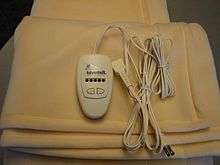Electric blanket

In the U.S and Canada, an electric blanket is a blanket with an integrated electrical heating device usually placed above the top bed sheet. In the U.K and Commonwealth, electric blanket commonly refers to an electric under the blanket (electric mattress pad), which is placed below the bottom bed sheet. Electric blankets usually have a control unit which adjusts the amount of heat the blanket produces. Blankets for larger sized beds often have separate controls for each side of the bed. The electric blanket may be used to pre-heat the bed before use or to keep the occupant warm while in bed.
Some modern "low voltage" electric blankets have thin carbon fiber wires and work on 12–24 volts.
History
The first electric blanket was invented in 1912 by American inventor Samuel Irwin Russell. This earliest form of an electric blanket was an ‘underblanket’ under the bed that covered and heated from below. There is some dispute about when the first electric over blankets were introduced. The first recorded publication of such a unit was in 1930 by Samson United Corporation.[1] However, others claim it was later in 1937 that electric 'over blankets', which lie on top of the sleeping person, were introduced in the United States.[2]
How they work
Much like heating pads, electric blankets use an insulated wire or heating element inserted into a fabric that heats when it is plugged in. The temperature control unit, located between the blanket and the electrical outlet, manages the amount of current entering into the heat elements in the blanket.
Modern electric blankets
Some modern electric blankets use carbon fiber wires to heat the user. These wires are far less bulky and conspicuous than older heating wires. Carbon fiber wires are also used as the heating element in many high-end heated car seats. Blankets can be purchased with rheostats that regulate the heat by managing body heat and blanket temperatures, ensuring a comfortable experience.
Safety
Newer electric blankets have a shutoff mechanism to prevent the blanket from overheating or catching fire. Older blankets (prior to about 2001) may not have a shut-off mechanism; users run the risk of overheating. Older blankets are considered fire hazards.
Some electric blankets work on a low voltage of 12 to 24 volts, including those which plug into ordinary household electrical outlets; in the US, such blankets are sold by Soft Heat, Serta, and Select Comfort.[3] Such blankets also include 12-volt blankets designed for in-car use; they tend to shut off automatically every 45 minutes or so.
Old or damaged blankets concern fire safety officials internationally. The use of such blankets is of concern due to the combination of heat, electricity, the abundance of flammable bedding material, and a sleeping occupant. In the UK, it is estimated that 5,000 fires per year are caused by faulty electric blankets,[4] of which 99% are believed to have been caused by blankets 10 years or older.[5]
Electric blankets also present a burn risk to those who cannot feel pain or are unable to react to it. Individuals included in this group are small children, diabetics, and the elderly.
Additionally, some individuals claim that electromagnetic radiation from electric blankets may cause negative health effects. However, there is little scientific evidence to support these concerns.[6]
Lastly, as with any source of heat over the groin, use of electric blankets can reduce fertility in men.[7]
In popular culture
A cartoon electrical blanket with its electrical temperature control acting as an anthropomorphic face named "Blanky" was portrayed in the 1987 film The Brave Little Toaster.
See also
- Bed warmer
- Heating pad
- Hot water bottle. This is a container which can be filled with hot water in the evening and which can help to keep a bed warm overnight.
References
- ↑ "Electric Sleeping Blanket for Winter Weather" Popular Mechanics, April 1930, bottom-right pg. 542
- ↑ Carlisle, Rodney P. (2004-07-19). Scientific American Inventions and Discoveries. John Wiley and Sons. ISBN 978-0-471-24410-3.
- ↑ In the US, as of October 2013, Perfect Fit Industries seems to be the only distributor of such blankets.
- See: Zimmerer, Richard. "Which is the Softest Electric Blanket?". Electric Blanket Institute website. Retrieved 2013-10-24.
Perfect Fit makes the SoftHeat Low Voltage, the Select Comfort and the Serta brands also.
- See: Zimmerer, Richard. "SoftHeat Low Voltage Electric Blanket Review including their Select Comfort and Chattam & Wells brands". Electric Blanket Institute website. Retrieved 2013-10-24.
Their electric blankets are the only ones in the USA conforming to the UL (Underwriters Laboratories) classification 'Non-hazardous Low Voltage'.
- See also the incomplete information at: "Perfect Fit Mattress Pad, Electric Blanket & Pillow Brands". Perfect Fit Industries, LLC. Retrieved 2013-10-24.
- See: Zimmerer, Richard. "Which is the Softest Electric Blanket?". Electric Blanket Institute website. Retrieved 2013-10-24.
- ↑ Haslam, Carl (2011). "Electric Blanket Safety". UK Fire Service Resources Group. Retrieved 2013-04-21.
Electric blankets account for over 5000 fires a year in the home and you can prevent these by taking some simple steps.
- ↑ http://www.fireservice.co.uk/safety/electric-blankets
- ↑ National Cancer Institute. "Magnetic Field Exposure and Cancer: Questions and Answers". National Institute of Health. Retrieved 23 November 2013.
- ↑ DePietro, MaryAnn. "Are Electric Blankets Safe?". SymptomFind.com. Retrieved 20 May 2014.
External links
- Safety information from the city of Fairfax, Virginia
- Detailed UK study on electric blanket safety (in Internet Archive)
- A 1998 CPSC document detailing differences in heating element construction between the US and European electric blankets